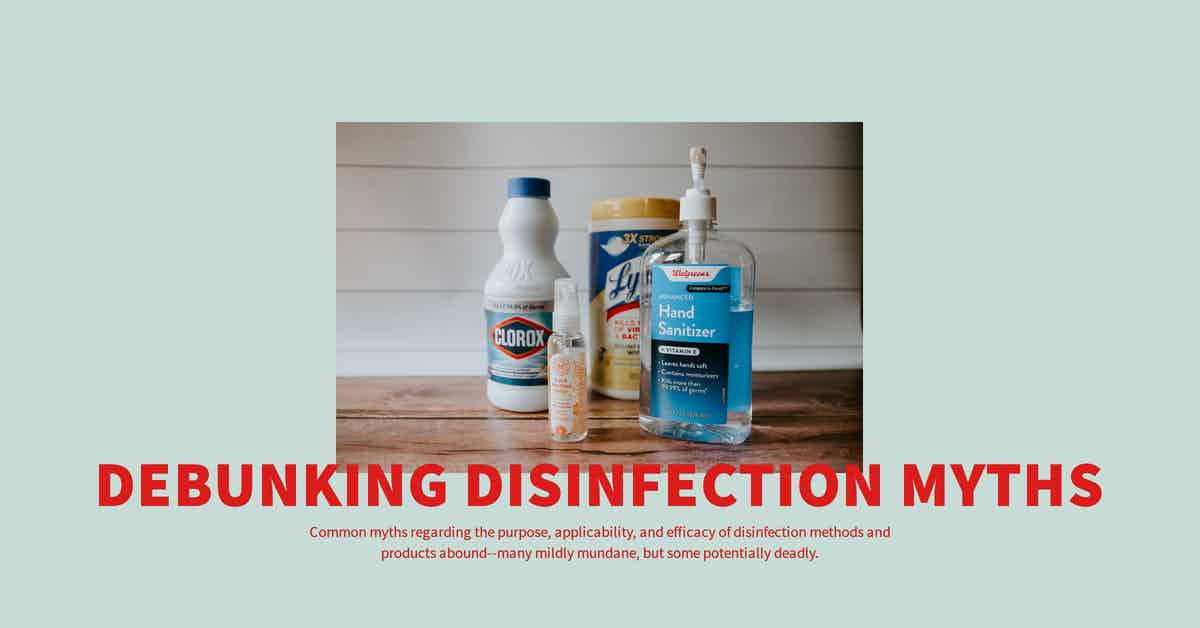Common myths regarding the purpose, applicability, and efficacy of sanitization methods and products abound--many mildly mundane, but some potentially deadly.

Common Disinfectant Misuses and Hazards
The COVID-19 pandemic brought to light the public's lack of basic understanding regarding sanitization products, hazards, methods, and efficacy.
The most commonly cited misuses of bleach and other disinfectants include:
- Drinking or gargling the disinfectant.
- Washing food with disinfectants.
- Washing or misting one's skin with disinfectants like it was a soap, and;
- Inhaling the vapors from the disinfectant.
According to a survey conducted by the US Centers for Disease Control and Prevention, which interviewed more than 500 US adults--in regards to safety precautions, storage, and recommended use:
- 23% believed that only room temperature water should be used for the preparation of diluted bleach solutions.
- 35% knew that bleach should not be mixed with vinegar.
- 58% knew that bleach should not be mixed with ammonia.
- 64% responded that eye protection was recommended for use of some cleaners and disinfectants.
- 71% responded that gloves were recommended for use.
- 68% responded that handwashing was recommended after using cleaners and disinfectants.
- 73% understood that adequate ventilation was recommended when using these products.
- 79% of respondents said that cleaners and disinfectants should be kept out of the reach of children, but;
- Only 54% knew that hand sanitizers should be kept out of the reach of children.
In regards to dangerously incorrect use of cleaning and sanitization products:
- 39% reported intentionally engaging in at least one high-risk practice not recommended by the CDC for the prevention of SARS-CoV-2 transmission.
- 19% applied bleach to food items.
- 18% used household cleaning and disinfectant products on their hands or skin.
- 10% said they had misted their body with a cleaning or disinfectant spray.
- 6% admitted to inhaling the vapors from household cleaners or disinfectants, and;
- 4% stated they had either drank or gargled diluted bleach solutions, soapy water, and other cleaning and disinfectant solutions.
25% of respondents reported at least one adverse health effect during the previous month that they believed had resulted from using cleaners or disinfectants, including:
- 11% - nose or sinus irritation.
- 8% - skin irritation.
- 8% - eye irritation.
- 8% - dizziness, lightheadedness, or headache.
- 6% - upset stomach or nausea, and;
- 6% - breathing problems.
Of those who reported adverse health effects, 39% admitted to engaging in high-risk practices more frequently than those who did not report the behavior at all (16%).
Common Cleaning and sanitization Myths
An analysis of available information online demonstrates the prevalence of several myths regarding cleaning and sanitization products and methods that could potentially result in harm and illness, including:
Cleaning and sanitizing are the Same Things
Cleaning with a soap-based detergent removes soil, oils, pathogens, bacteria, and fungi from surfaces, but typically--SARS-CoV-2 being a notable exception--does not kill pathogens.
Disinfectants kill germs, bacteria, and other microbes on surfaces, with several caveats:
- Not all disinfectants are designed or approved by the EPA for use against all pathogens, pathogenic bacteria, fungi, and other microbes.
- The EPA does not recognize any claim of residual efficacy by any disinfectant manufacturer.
- Not all disinfectant products are appropriate for use on all surfaces.
- To achieve maximum efficacy, a surface must be cleaned with soap and water, then allowed to dry before applying a disinfectant, and;
- Disinfectant products have different dwell times in which the surface being sanitized must remain wet with the product for a specific amount of time to achieve full efficacy and meet all registered claims.
Green or Safer Choice Disinfectants are not as Effective
The US Environmental Protection Agency maintains several databases of products with registered claims against common pathogens and pathogenic bacteria.
Each list can be sorted by active ingredient.
Many lists, such as List N (SARS-CoV-2), contain approved products with active ingredients considered safer for humans and the environment, including Citric Acid and Hydrogen Peroxide.
Further, the EPA maintains lists of Safer Choice approved products and a Sustainable Marketplace for greener products and services.
References & Resources
- Knowledge and Practices Regarding Safe Household Cleaning and sanitization for COVID-19 Prevention — United States, May 2020
- Selected EPA-Registered Disinfectants
- Search Products that Meet the Safer Choice Standard
- Sustainable Marketplace: Greener Products and Services
Takeaway
Commercial-grade detergents and disinfectants should only be handled by trained personnel wearing required protective equipment.
Misuse and mishandling, even safer cleaning and sanitization products, can and has resulted in illness and hospitalization, as well as the ensuing drops in occupant productivity and increase in medical expenses.
Further, the inappropriate use and disposal of commercial-grade disinfectants increase the preventable waste of vital resources and damage the natural environment.
Additionally, misapplying the incorrect cleaning and disinfectant product to certain surfaces will damage the built environment, decreasing the useable lifespan of equipment, flooring, and furniture, resulting in significantly higher ownership costs.
Outsourcing is a proven method for onboarding highly in-demand cleaning and sanitization services and experience for a fraction of the price of maintaining a similar service in-house.
If you would like more information regarding the effectiveness of high-performance infection prevention and control measures, or if you would like to schedule a free, no-obligation on-site assessment of your facility's custodial needs, contact us today for a free quote!
In Bakersfield, CA, call (661) 437-3253
In Fresno, CA, call (559) 206-1059
In Valencia, CA, or Santa Clarita, CA, call (661) 437-3253
In Palmdale, CA or Lancaster, CA, call (661) 371-4756

